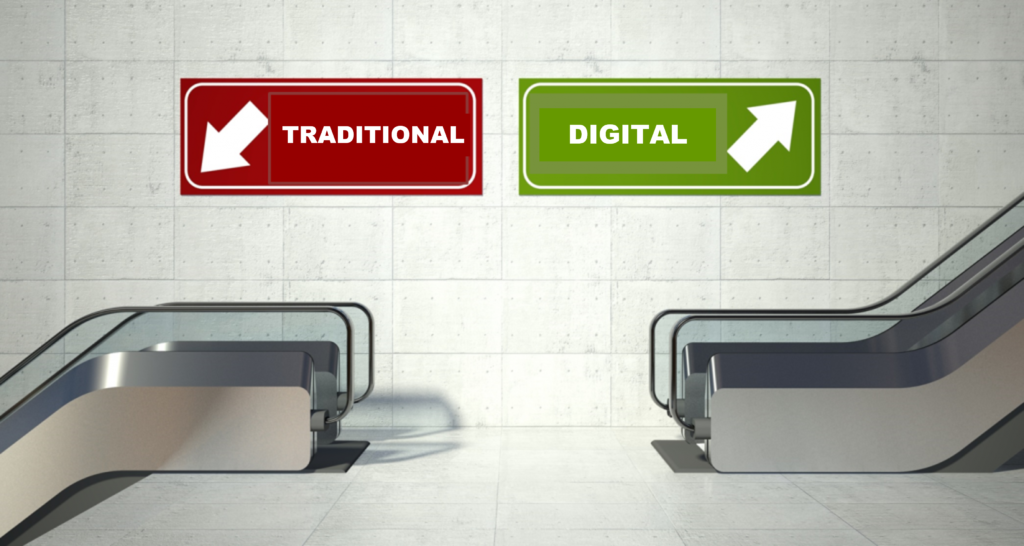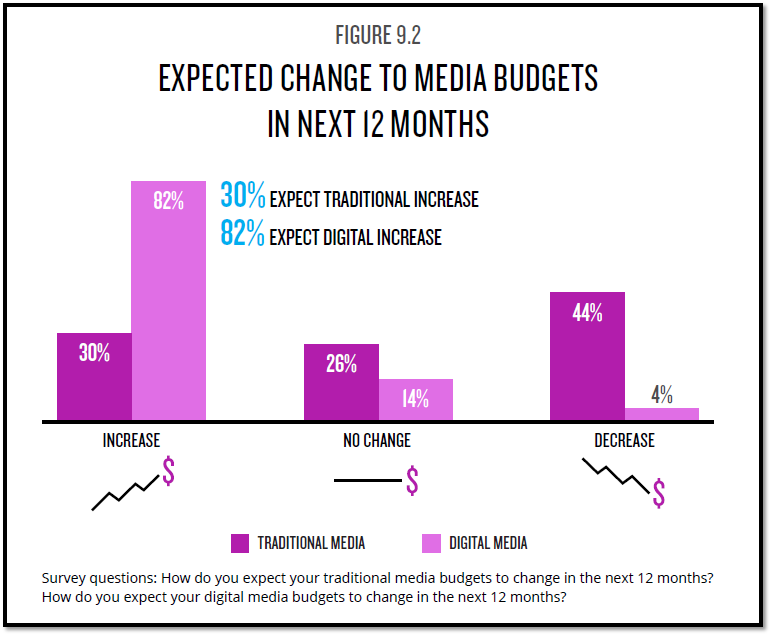
In yesterday’s post, we took an uncomfortable look at radio’s image problems among consumers. It turns out the a Google search – when autocomplete kicks in – tends to display many not-so-nice descriptors about the state of the industry.
(As we also learned, many other media outlets don’t fare very well in Google searchers either.)
But to support the notion that broadcast radio is beset with image problems, Nielsen released a new study this week among marketing executives that reinforces broadcast radio’s shaky reputation as an effective advertising tool in 2018. It’s a valuable read.
Conducted by a team led by Nielsen’s SVP Marketing and Strategy, Eric Solomon, it’s their very first study conducted among Chief Marketing Officers – or CMOs. And it’s an eye-opener, especially when it comes to the trajectories of digital and traditional media, and the end-users who strategically and tactically employ them to market their products and brands.
The report focuses on a number of key factors, including CMOs projecting their ad spend on both traditional media and digital media in the next year. This chart speaks volumes about the different directions each media group is moving. Digital has the momentum arrows, while traditional’s gains are offset by the stark reality that more than four in ten marketers say they’ll be decreasing their ad spend on “old media.”
While digital media is often misunderstood by even sophisticated marketers, there’s a growing sense it provides more effectiveness and return on ad dollar investment.
Nielsen’s study of 165 CMO types, conducted earlier this year, reflects similar surveys we’ve conducted among advertising agencies, as well as local businesses in a variety of markets around the U.S. While many of those who make marketing decisions may not understand the intricacies of social and/or digital media, they tend to have more confidence in its efficacy. And their patience with “spray and pray” media buys that may or may not reach their target consumers is running thin.
That suggests some of the same perceptual problems exist about radio among CEOs that we discussed in yesterday’s Google search blog post about listeners. When more consumers believe that radio has had better days, and marketers think it’s simply not an especially effective or important tool in the traditional ad arsenal, it’s a problem.
This chart from the same study suggests that even in the legacy media arena, radio is a laggard;

The full report runs 66 pages, and provides valuable insights into what marketers are thinking, and how their world is changing. You can access it here.
Attribution and ROI are key themes, too – and therein lays the opportunity. These new values go a long way toward explaining radio’s challenges – and its opportunities – in this increasingly complex marketing environment.
In that context, it’s somewhat surprising digital media doesn’t fare any better in instilling confidence in delivering return on investment for advertisers. Traditional media, of course, is no better. But the fact ROI is up for grabs suggests there’s plenty of time for radio to settle on attribution model(s) that marketers believe in.
This chart sums up the horse race between traditional and digital when it comes to return on investment:

For radio, its future as a viable marketing tool may rest with its ability to provide a higher level of attribution – and convince advertisers has always worked and still works today. Just contending that radio’s reach outdoes the other players isn’t a sufficient argument. And emerging new tools from third party newcomers like Analytic Owl , Connected Travel, and Veritone are already on a path toward connecting many of the dots between consumers, radio, and advertisers.
But that still doesn’t change yesterday’s key points from Seth Resler about radio’s need to reboot its image among its two audiences: listeners and marketers.
A medium that is so technically simple and solid, established for a century, and part of millions of people’s media lives deserves better than to simply be cast in in a bucket with other traditional media.
New lines are being drawn, new best practices are being written, and new models are being tested. That suggests the future is very much up for grabs for media players that can effectively make the case they produce results.
Our 4-pack of suggestions for broadcast radio in yesterday’s post has value in the marketing space, too:
- Radio as an industry must speak in one voice
- Radio needs to step up and fund a national marketing campaign – targeted at both the audience and advertisers
- There’s a lot to be learned from how other industries have rebooted their images – from milk to pork
- The same old radio reach narrative has fallen short – it’s time for something new
And let’s add attribution to the mix of solutions rapidly becoming available to radio broadcasters.
Advertisers are looking for solutions in these turbulent times.
Anybody can emerge a winner in this game: Facebook, Google, Pandora, SiriusXM…
…or even traditional broadcast radio.
- What To Do If Your Radio Station Goes Through A Midlife Crisis - April 25, 2025
- A 2020 Lesson?It Could All Be Gone In A Flash - April 24, 2025
- How AI Can Give Radio Personalities More…PERSONALITY - April 23, 2025




When a one-time top model lets themselves go, gains 30 pounds, wears old, outdated clothes, uses dated references and refuses to buy anyone drinks – they shouldn’t be surprised that people don’t flock to them at a bar anymore. And a new publicist won’t help them – a diet, exercise program and makeover will. More publicity will only call attention to everything this model has let slide.
Remember that Jim Carrey movie, “Liar Liar” where he played a lawyer who couldn’t tell a lie? What if this national ad campaign for radio played by those rules?
“Radio – pretty much the same product as 25 years ago, but done cheaper.” “Radio – the medium you remember from 1993 but with much less local talent, almost no marketing and way less research.” “Radio – where the “I” in ROI stands for inconsistency. Bucking the trends in digital where every click and what follows is trackable in real time, radio offers after the fact broad stroke ratings, with inconsistent, incompatible methodologies that are at times accredited.”
Perhaps radio doesn’t suffer from an image problem – it could be that given the lack of resources applied to the product, its measurement and the sales of both since the consolidation era, radio is incredibly lucky to still be used by almost everyone and only down in revenue by 1/3.
While much of what the ad community believes about radio listenership isn’t true, the trends they sense are. When you invest almost nothing in a product, almost all your innovation is focused on cost cutting and you face more competition than every before, it’s almost delusional to think that your consumers and clients won’t notice.
I expect to be lambasted for this post, but someone with nothing to gain or lose needs to offer some tough love. Radio would do well to update its product, marketing, measurement and sales efforts before launching a national ad campaign, which at this stage could well reinforce more stereotypes than it dispels.
I’m certainly not going to lambast you for these comments, Bob. I find them insightful if (at times, painfully) honest.
It’s a reminder, (what was the old Sarah Palin line about lipstick on a pig?), that simply a new, catchy slogan won’t suffice. And nothing in Fred’s columns, which I read daily, suggest to me he or other fans of the medium feel otherwise. Yes, the girl at the bar needs to reassess her appearance before calling too much attention–which could end up being unwanted attention–to herself. May radio watch and learn.
Bob, the fact that no one lambasted you suggests agreement (or at worst, apathy) with your thoughts. I suspect it’s the former. And perhaps my exhortation to market is somewhat premature. Whether radio has an image problem, a reality problem – or both – is debatable. And I’m glad this post served as a jumping off point for some strong commentary. Thanks for being part of it.
FALLACY ALERT:
Unique 800#s do not provide accurate attribution in DR radio — because if folks cannot remember (or dial them while driving) then listeners either don’t dial them, or go to Google (which means Radio loses credit for driving the lead).
Analytic Owl and other web traffic systems use an 8-10 minute window (after an ad plays) to credit that ad for driving the web visit. Think about it folks: per RAB, 75-84% of broadcast radio listeners are DRIVING, which means they cannot visit a website immediately OR within a 10 minute window, if they are in the middle of their commute.
However if the radio listener is invited to dial #250 and say the brand keyword, they DO connect, and Radio gets the credit / attribution.